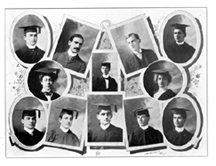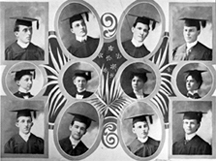Holdings:
* UM-System
* Columbia
All illustrations in this exhibit are thumbnails. Please left-click on these illustrations to bring up larger images.
Departments in 1900
Psychology and Sociology
In 1900 and with Jesse's blessing, the departments of Experimental Psychology and Sociology were created. Psychology was deemed important to those studying to become teachers and sociology was considered important to the general public. Five hundred dollars was allocated to install the psychology lab, which was a substantial sum of money in those days. To keep the amount in perspective, three desks and three chairs for the library were under fifty dollars. Max Meyer, a well known professor, was hired to begin the program. In addition to bringing an interest in the psychology of music, Meyer also proposed "grading on the curve." Although his colleagues rejected the idea, later faculty members and generations of Mizzou students have acknowledged its advantages.
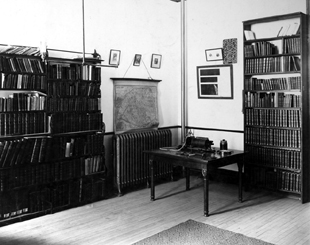
1901 Experimental Psychology Lab
(University Archives, C:0/47/1, Box 1, OSF)
Military
It has been claimed that the University of Missouri sent a larger percentage
of its students to the front in the Spanish American War (1898) than any
other college in the United States.
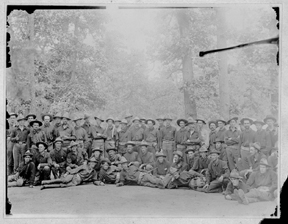
University of Missouri Volunteer Infantry in Spanish American War
(University Archives, C:22/8/1, Box 1)
After the war, the enrollment in the Military Department did not drop
but increased consistently until the turn of the century. There were 290
men enrolled in 1900, nearly one third of the student body. The style
of uniforms, the fabric, and the selection of tailors generated much correspondence
and discussion during the year. The photo which follows captures
the winning entry.
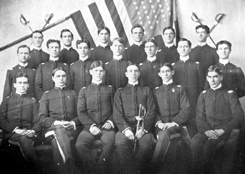
(University Archives, 1900 Savitar)
Students in 1900
There were more than 1300 students enrolled in the 1900-1901 academic
year. There were fifty-two states, territories, and countries represented
in those figures. There was, for example, a student from Cuba, one
from New Zealand, four from Argentina and twenty-four from Kansas.
For those graduating in the academic year 1900, the average age of the class was 24 years, and one month, the oldest member was 30, the youngest was 19.
The Seniors had completed their required credits, but there is another perspective. What about those individuals beginning in 1900. What did it take to be admitted into Missouri State University?
If you attended an Approved High School of which there were more than 100 schools with 100 more petitioning to be included on the list, your grades and diploma were not enough to gain entry. A certificate had to be signed by the superintendent or principal of the high school showing the course of study which the student completed. If the documentation was accepted, the student was spared a rigorous examination. For the unfortunate student, the next step was four days of exams in eighteen different subjects.
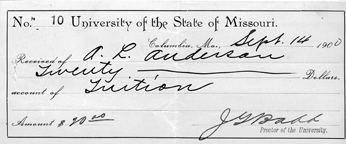
1900 Student Receipt
(University Archives, UW:1/4/1, Box 10, FF 3B)
Another benefit to graduating from an approved school, besides the avoidance
of exams, was a possible waiver of expenses. The Board of Curators
decreed that tuition was free for all students in all departments
from 1 September 1900. There was still the entrance, library, and incidental fee of $5. For many students, even this fee was beyond their means. If you had the highest average in your approved school, however, then the $5 fee was waived.
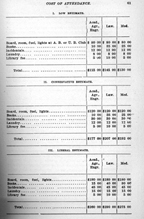
1900 Chart of Expenses
(University Archives, Bulletin, 1900-1901)
The fee for law students was $10 and as the above chart indicates, many
of their other expenses were higher as well.
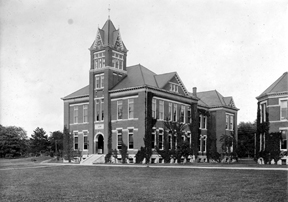
Law Building
(University Archives, C:0/47/12, Box 1, FF 27)
Once a student was admitted, the daily routine began. Lectures and recitations in all departments, again except Law, were held 6 days a week. No student was allowed to enroll in more than 18 hours and the typical course load was 12-16 hours, much like today. Yet, there was
one daily activity which is not in practice today, religious exercises. Every morning there was a hymn by the choir, readings from the Old and New Testaments, a brief prayer, and a closing hymn.
Housing in 1900
Room rent for each student was from $12 to $30 a year, according to
the location of the room. Permits to the dining room were $12 a year, but
in 1899 and again in 1900, the cooks struck. After an increase in salary
each year, the delivery of meals continued uninterrupted.
The cost quotes pertain only to men, since the costs for women were more expensive.
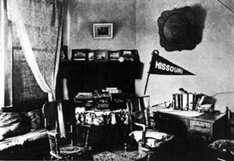
A Room in Lathrop Hall, ca. 1905
(University Archives, C:0/3/8, Box 4, FF 9)
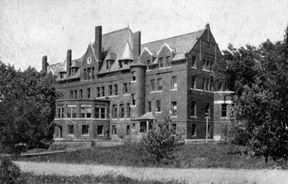
Lathrop Hall, ca. 1900
(University Archives, C:0/47/12, Box 1, FF 57)
Please click here to view Page Four of Y1.9K.
